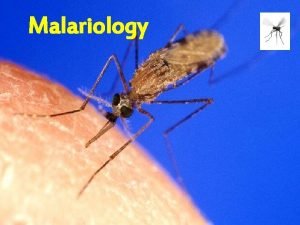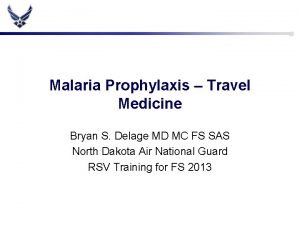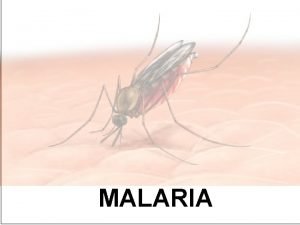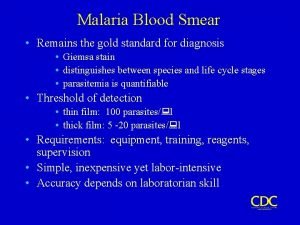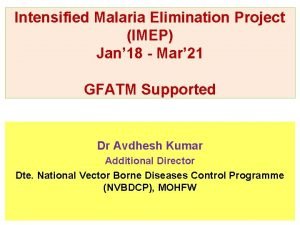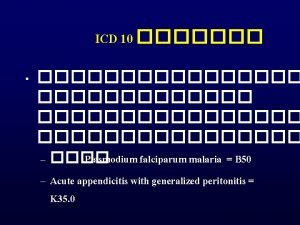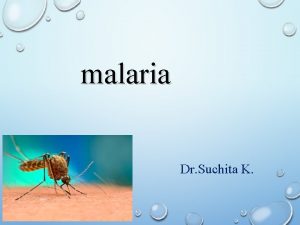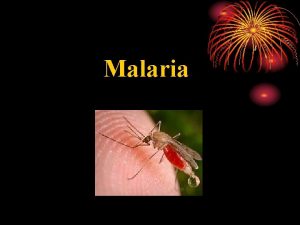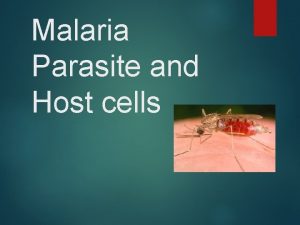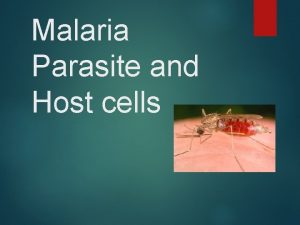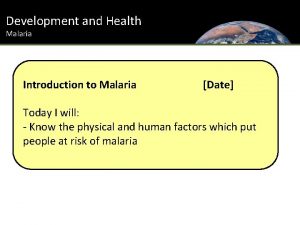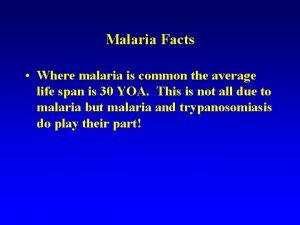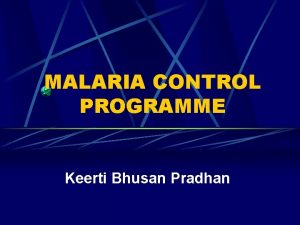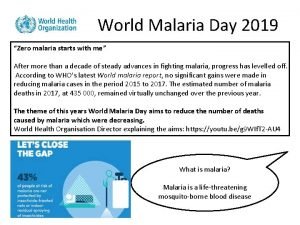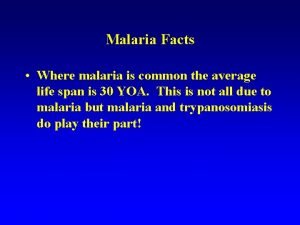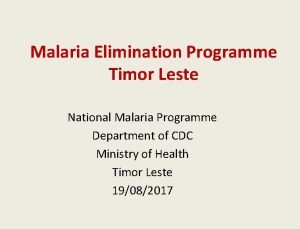Introduction to Malaria Prevention Part 2 Malaria Prevention






















- Slides: 22

Introduction to Malaria Prevention Part 2 Malaria Prevention and Control Office of Overseas Programming & Training Support (OPATS)

Session Learning Objectives: 1. By the end of the session, participants will list at least three malaria prevention strategies and explain which strategies are promoted by the Ministry of Health or National Malaria Control Program in their host country. 2. Using what they have learned from their host families and from their participation in the training session, participants will cite three most common post-specific barriers (physical or behavioral) to net usage, and strategies to overcome these barriers. 3. By the end of the session, participants will articulate their role in malaria prevention, elevator speech style, in relation to the goals of: • the U. S. President’s Malaria Initiative • Peace Corps’ Stomping Out Malaria in Africa initiative • the National Malaria Control Program at their post

High Risk Groups HIV Positive Pregnant mothers Non-immune foreigners such as Peace Corps Volunteers … Children (especially <5)

Diagnosis Microscopy • The gold standard • Requires trained clinicians, electricity, equipment • Measures BOTH presence AND severity of malaria Rapid Diagnostic Tests T! • RDTs are highly effective (high 90 s% accuracy) N A • Don’t require extensive training for the clinicians, PORT IM electricity, cold chain, etc. • ONLY measures the presence, NOT severity, of malaria Clinical Diagnosis • Looking for occular whitening, retinal hemorrhaging, jaundice, splenomegaly • A viable alternative in places where there are no advanced diagnostics available

Treatment and Resistance • Drug combinations are better than monotherapy • Incorrectly taking drugs increases the chance of resistance development – there’s a BCC goal here… • Significant resistance to chloroquine and sulfadoxinepyremethemine. Artemisinin resistance negligible but growing • Resistance does not necessarily mean 100% resistance Current WHO-approved treatments • ACTs are the WHO-recommended treatment for uncomplicated malaria • Complicated malaria is beginning to be treated with IV ACTs though the use of IV quinine is still common The Dark Side • A Global Fund study in 2011 found over 50% of all malaria drugs taken in Africa were NOT WHO recommended – monotherapies or counterfeits • Encouraging people to seek real ACTs is vital!

The Four Pillars of Malaria Prevention Early Care Seeking IRS IPTp Well Trained Community Health Workers LLINs

Early Treatment It takes 2 to tango transmit Early treatment not only increases the patient’s chance of a good outcome – it also REDUCES THE CHANCE OF TRANSMITTING TO OTHERS!

Indoor Residual Spraying/Covering Kills mosquitoes where they like to rest Chemicals are safe Resistance is an issue IRS is expensive: $5 - $30 per household depending on the chemical used • Requires well-trained technicians • Impregnated wall coverings are a new solution • •

Indoor Residual Spraying/Covering Q: Hey, waaaaaiiiit a minute… Didn’t Al Gore say poison was bad? A: While no one likes the idea of spraying chemicals in the home, all chemicals used in IRS must pass a strenuous WHO testing regimen detailed here: http: //www. who. int/whopes Q: Isn’t there a controversy about the use of DDT for this application? A: While DDT has been approved for this use, almost all countries have moved away from its use for the simple reason that many mosquitoes are now resistant to it.

Intermittent Presumptive Treatment for pregnant women - IPTp • Pregnant women are particularly susceptible to malaria • Malaria parasites may “hide” in the placenta making testing for malaria difficult • Malaria in Pregnancy (Mi. P) can cause anemia, low birth weight and infant death

IPTp Preventative measures • Sleep under an LLIN • Presumptive Treatment (IPTp) of sulfadoxine-pyrimethamine (SP) – at least two doses given at least a month a part starting at quickening At the Antenatal Clinic (ANC) • In addition to IPTp, micronutrient supplements (iron/folate) are provided • Key service provider to pregnant women. Q: Heeeeey… wait a minute… didn’t you say that there was a lot of resistance to sulfadoxine-pyrimethamine (SP)? A: Why yes we did. There is a significant amount of resistance to SP in the parasite population in Africa and it is no longer recommended for non-pregnant adults. BUT due to the specific nature of malaria in pregnancy – the tendency for the parasite to sequester itself in the placenta and the specific form the parasite takes in order to do so – SP is still effective and recommended for pregnant women!

Long Lasting Insecticide-Treated Nets (LLINs) Modern LLIN – Good for roughly 20 washes Older nets - Required periodic re-treatment

LLINs – The Community Effect In communities with low coverage rates, mosquitos are deflected from net users. The users malaria burden goes down but it only marginally decreases the overall burden of malaria on the community, mostly it shifts the burden to those who don’t have nets. When a village has Universal Coverage (defined as 80%), you can actually decrease the vector population and with it: • Child mortality of the entire community • Burden on the health post • Scholastic absenteeism • Etc.

Quiz Show 1) Achieving Universal Coverage is vital because when over 80% of a population sleeps under a mosquito net they achieve a “ _____ effect” which reduces the vector population. a) community b) knock-down c) vector d) Lagrange 2) IRS and LLINS cancel each other out and should NOT be used together. a) True b) False 3) Due to the difficulty of detecting placental malaria and its severe effects, pregnant women are presumptively treated with a) Artemisinin b) Dihydro-oxygen c) mefloquine d) Sulfadoxine-pyremethemine 4) Encouraging Early Care Seeking Behavior is difficult because: a) Many adults have survived multiple cases of malaria and don’t consider it life-threatening b) Adults may not be aware that they are capable of passing on malaria when they are symptomatic c) They may not have the economic means to pay for treatment d) All of the above 5) Which of the following is NOT TRUE about Indoor Residual Spraying (IRS)? a) Resistance is an issue because of agricultural use of similar insecticides b) It is effective because mosquitos tend to rest on the interior walls of dwellings c) It is inexpensive d) It requires skilled technicians to apply correctly

Quiz Show 1) Achieving Universal Coverage is vital because when over 80% of a population sleeps under a mosquito net they achieve a “ _____ effect” which reduces the vector population. a) community✔ b) knock-down c) vector d) Lagrange 2) IRS and LLINS cancel each other out and should NOT be used together. a) True b) False✔ 3) Due to the difficulty of detecting placental malaria and its severe effects, pregnant women are presumptively treated with a) Artemisinin b) Dihydro-oxygen ? c) mefloquine d) Sulfadoxine-pyremethemine ✔ 4) Encouraging Early Care Seeking Behavior is difficult because: a) Many adults have survived multiple cases of malaria and don’t consider it life-threatening b) Adults may not be aware that they are capable of passing on malaria when they are symptomatic c) They may not have the economic means to pay for treatment d) All of the above ✔ 5) Which of the following is NOT TRUE about Indoor Residual Spraying (IRS)? a) Resistance is an issue because of agricultural use of similar insecticides b) It is effective because mosquitos tend to rest on the interior walls of dwellings c) It is inexpensive✔ d) It requires skilled technicians to apply correctly

We must all hang together or… Square net Round or “hoop” nets Baby net NOTE: These are available in many markets but are rarely treated – offering only a physical barrier.

How hanging can go wrong § What are some things to look out for when hanging nets? § What are some ways that you’ve seen nets get damaged? K BAC K L TA

How hanging can go wrong § Nets hung too high are repeatedly stretched § Nets hung too low are stepped on and are more likely to blouse out to the point where they can be burned by nearby candles § Nets hung too low can also catch on sharp bamboo or sticks on the bed

Challenging hangings

Hindrances to a habit of hanging § What are the behavioral barriers to net hanging? § How about physical barriers that don’t pass the sniff test – “I don’t have string” – that are really behavioral barriers? § How can we overcome them? ACK KB TAL

Taking it to scale

Thank you "Our response to this problem will define this generation. What will you say when your children ask you, 'How did you let so many women and children die when you had the ability to save them and you knew? ' Will we say that we didn't care, that we didn't care enough? This situation is solvable. ” - Cynthia Scharf, UN Office for the Coordination of Humanitarian Affairs (Jan. 3 rd, 2007)
 Primary prevention secondary prevention tertiary prevention
Primary prevention secondary prevention tertiary prevention Enlargement of a lymphoid organ in the luq
Enlargement of a lymphoid organ in the luq Trypanosoma bruzi
Trypanosoma bruzi Cause of splenomegaly in malaria
Cause of splenomegaly in malaria Dot
Dot Etiology of malaria
Etiology of malaria Obat malaria dhp
Obat malaria dhp Malaria means bad air
Malaria means bad air Malaria prophylaxis
Malaria prophylaxis Apikomplex
Apikomplex Piremetamina
Piremetamina Gold standard for diagnosis of malaria
Gold standard for diagnosis of malaria Imep full form in malaria
Imep full form in malaria Malaria in uganda facts
Malaria in uganda facts Falciparum malaria icd 10
Falciparum malaria icd 10 University of pecs faculty of health sciences
University of pecs faculty of health sciences Complicated malaria
Complicated malaria Malaria in pregnancy definition
Malaria in pregnancy definition Malaria in pregnancy definition
Malaria in pregnancy definition Epidemiological triad of malaria
Epidemiological triad of malaria Makalah surveilans malaria
Makalah surveilans malaria Malaria
Malaria Malaria
Malaria







